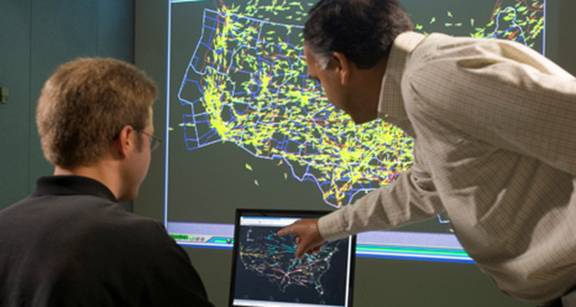



Invention of the Year Award for 2006
The Government Invention of the Year for 2006 is the MacroFiber Composite Actuator and Sensor (MFC), developed at NASA’s Langley Research Center. The MFC is an embodiment of a new type of piezoelectric device. When voltage is applied to a piezoelectric device, an electric field is generated parallel to the piezoelectric fibers. This electric field produces a uniform mechanical strain proportional to the applied electric field up to a saturation point. Conversely, when the device is mechanically strained, a voltage is produced in response to the magnitude and direction of the applied load. The MFC technology is a complete make over and refinement of earlier methods to enable the fabrication of piezoelectric actuators and sensors with increased performance, reliability and manufacturability at reduced cost. For instance, rather than use expensive round piezoelectric fibers, the MFC uses commercial piezoelectric wafers that are diced into square fibers and placed, pre-aligned, directly onto commercially produced polyimide copper films. There is no direct handling of the piezo-material, no health issues with lead oxides and no fiber breakage.
Additionally, the concepts used to make the MFC allows for the robust assembly of most any commercial dielectric "smart" materials to be assembled into a low cost, durable, flexible, sealed package for use as both an actuator and sensor in a variety of shapes and sizes. When compared to standard piezoelectric systems, the MFC is much more durable and provides increased unidirectional control. Furthermore, the MFC is designed to be readily integrated into a system as an add-on component or integrated during manufacture. The MFCís flat profile and use as a sensor and an actuator allows for use in critical or tight areas where other technologies with larger volumetric profiles cannot be used. This technology, in combination with the ability to self power wireless circuitry from the electricity generated from flexing the MFC, enables additional health monitoring application on complex rotating components, such as turbomachinery, or in remote areas, such as hazardous environments, where additional wiring and power sources can be extremely difficult to implement.
MFC has been used experimentally on a number of NASA missions to prove concepts, including mitigation of buffeting of vertical stabilizers on aircraft, solar sails and inflatable space structures, morphing systems, structural health monitoring devices, vibration damping and noise cancellation strategies, structural shaping and stiffness control, aeroelelastic instability mitigation, and dozens of other active control solutions. It has also found commercial applications in similar areas, most notably for reduction of vibration in automotive drive shafts for Volkswagen.
Software of the Year Award for 2006
FACET, developed at NASA’s Ames Research Center, is a flexible software-based simulation environment for exploration, development, and evaluation of advanced Air Traffic Management (ATM) concepts. Examples of concepts studied using FACET are: aircraft self-separation for Free Flight, modeling and prediction of air traffic controller workload, a decision support tool for direct routing, integration of space launch vehicle operations into the U.S. National Airspace System (NAS), and advanced traffic flow management techniques using rerouting, metering and ground delay. FACET models system-wide airspace operations over the contiguous U.S. Airspace. Models (e.g., Center/sector boundaries, airways, locations of navigation aids and airports) are available from databases. Weather models (winds, temperature, bad weather cells, etc.) are also available. FACET models aircraft trajectories using round-earth equations. Aircraft can be flown along either flight plan routes or direct (great circle) routes as they climb, cruise and descend according to their individual aircraft-type performance models. Since this is about to be used by the Federal Aviation Administration for optimally rerouting aircraft during system upsets beginning this fall, the technology has become far more valuable to the Nation.
 ICB Home
ICB Home Back
Back

